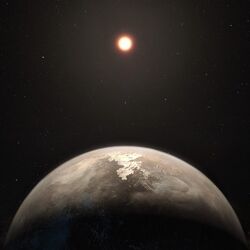Astronomy:Teegarden's Star b
 Artist’s impression of Teegarden’s Star b | |
| Discovery | |
|---|---|
| Discovered by | Zechmeister et al. |
| Discovery site | Calar Alto Observatory |
| Discovery date | June 2019 |
| Orbital characteristics | |
| 0.0252+0.0008 −0.0009[1] AU | |
| Eccentricity | 0+0.16 −0[1] |
| Orbital period | 4.91±0.0014[1] d |
| Star | Teegarden's Star[1] |
| Physical characteristics | |
| Mass | ≥ 1.05+0.13 −0.12[1] M⊕ |
| Physics | 301 K (28 °C) |
Teegarden's Star b (also known as Teegarden b) is an exoplanet found orbiting within the habitable zone of Teegarden's Star, an M-type red dwarf 12.5 light years away from the Solar System. It has the highest Earth Similarity Index of any exoplanet found to-date.[2]: 106 Along with Teegarden's Star c, it is among the closest known potentially habitable exoplanets.[3][4]
Discovery
In July 2019, a team of more than 150 scientists led by Mathias Zechmeister published a peer-reviewed article in Astronomy & Astrophysics as part of the CARMENES survey supporting the existence of two candidate exoplanets orbiting Teegarden's Star.[1]
Because of the alignment and faintness of Teegarden's Star, Doppler spectroscopy (also known as the radial velocity method) was necessary to detect possible exoplanets. This method detects exoplanets indirectly by observing their effects on a host star's radial velocity, the speed at which it is moving towards or away from the Earth. These radial velocity anomalies in turn produce doppler shifts observable with a spectrograph-equipped telescope of sufficient power.
To accomplish this, the team used the CARMENES instrument on the 3.5-meter telescope of Spain's Calar Alto Observatory.[1][5] After three years of observation,[6] two periodic radial velocity signals emerged: one at 4.91 days (Teegarden's Star b) and another at 11.41 days (Teegarden's Star c).[1][7]
Physical characteristics
Mass and orbit
Teegarden's Star b is the innermost known planet orbiting Teegarden's Star, with an orbital period of just 4.91 days. The planet's minimum mass is 1.05 Earth masses (M⊕); this value would be the true mass if the planet's orbit is not inclined from the Earth's perspective.[1] Because of this, Teegarden's Star b is likely to be rocky.[8] Astronomers estimate that Teegarden's Star b has a 60 percent chance of having liquid water, but only a 3 percent chance of having an atmosphere.[2]: 105–107
Host star
Teegarden’s Star is a low-mass red dwarf, with a mass of around 9 percent the mass of the Sun, and with a temperature of around 2,900 Kelvin (2,623 °C or 4,760 F). Due to the very low temperature and luminosity of Teegarden's Star, it was only discovered in 2003, since it has an apparent magnitude of only 15.1 (and an absolute magnitude of 17.22). Like most red and brown dwarfs, it emits most of its energy in the infrared spectrum. It is also older than the Sun, with an age of at least 8 billion years.[9]
Habitability

Teegarden's Star b orbits within the habitable zone of its host star, meaning it is possible that its atmospheric composition could allow for stable liquid water on its surface, which could have also allowed the development of life.[7]
See also
References
- ↑ 1.00 1.01 1.02 1.03 1.04 1.05 1.06 1.07 1.08 1.09 Caballero, J. A. et al. (12 June 2019). "The CARMENES search for exoplanets around M dwarfs. Two temperate Earth-mass planet candidates around Teegarden's Star" (in en). Astronomy & Astrophysics 627: A49. doi:10.1051/0004-6361/201935460. ISSN 0004-6361. Bibcode: 2019A&A...627A..49Z. https://www.aanda.org/articles/aa/pdf/forth/aa35460-19.pdf.
- ↑ 2.0 2.1 Carroll, Michael (2020). Envisioning Exoplanets: Searching for Life in the Galaxy. Smithsonian Books. ISBN 978-1-58834-691-9.
- ↑ "The Habitable Exoplanets Catalog". University of Puerto Rico at Arecibo. https://phl.upr.edu/projects/habitable-exoplanets-catalog.
- ↑ Suárez Mascareño, A. et al. (December 2022). "Two temperate Earth-mass planets orbiting the nearby star GJ 1002". Astronomy & Astrophysics 670: A5. doi:10.1051/0004-6361/202244991. Bibcode: 2023A&A...670A...5S.
- ↑ "CARMENES • Instrument". https://carmenes.caha.es/ext/instrument/index.html.
- ↑ "Moreover, we have shown that the 4.9 d signal is stable over the three years of observations in period and amplitude."[1]: 8
- ↑ 7.0 7.1 Cassella, Carly (June 19, 2019). "We Just Found 2 of The Most Earth-Like Exoplanets Yet, Only 12.5 Light Years Away". https://www.sciencealert.com/two-earth-like-planets-found-orbiting-a-star-just-12-light-years-away.
- ↑ Chen, Jingjing; Kipping, David (2017). "Probabilistic Forecasting of the Masses and Radii of Other Worlds". The Astrophysical Journal 834 (1): 17. doi:10.3847/1538-4357/834/1/17. Bibcode: 2017ApJ...834...17C.
- ↑ "Two potentially life-friendly planets found orbiting a nearby star" (in en). 2019-06-18. https://www.nationalgeographic.com/science/article/two-potentially-life-friendly-planets-found-12-light-years-away-teegardens-star.
 |


